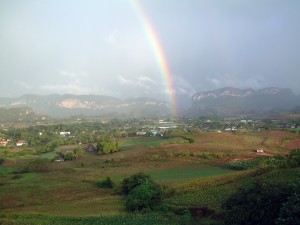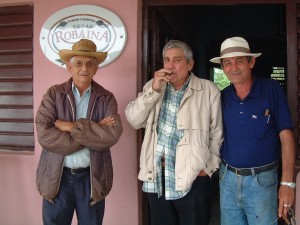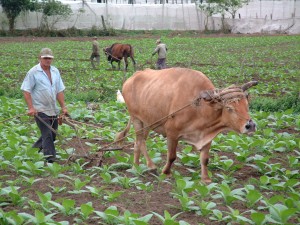Just before Christmas 2000, I went with my wife and two New York friends to visit the famous Las Vegas de Robaina (in this case it was Finca la Piña, located in Cuchillas de Barbacoa.) We had traveled from Havana to Pinar del Rio in a rented Peugeot, stopping en route to visit one of the sugar mills that had been owned by the company that my father had worked for BC, once known as Central Merceditas and now called Central Sandino. The less than friendly response to our visit there led us to go immediately to the tobacco fields further West in Cuba’s westernmost province. We stayed at a hotel with a fabulous view of Viñales, a verdant valley punctuated by massive limestone escarpments that seemed to rise out of the valley floor like dragon’s teeth. In Cuba these were called mogotes, and they were especially stunning to view against the spectacle of an evanescent rainbow.
We left the next day for the region known for Cuba’s (and perhaps the world’s) best tobacco, Vuelta Abajo. In the late morning the four of us, using the Knopf guidebook that we had with us, made our way to the vicinity of the Robaina finca, and needing directions, pulled up at a bus stop with perhaps twenty people waiting patiently . . . for what else was there for them to do? All but one, that is, a young man who eagerly came to my window and asked if we were looking for the Vega Robaina. With my affirmative, and without further ado, he quickly took his place in the back seat—much to the discomfiture of our friends in back—as though we’d been expecting him to join us for the ride. As it turned out, we never would have found the farm on our own, for there was no sign and no road of any kind, but Alexis (for that was his name) pointed out a cart track for us to follow. Make that a bullock cart track, just to be clear. So we bounced our way for about ten minutes until we pulled into a shaded parking space.
I had been smoking a contraband cigar that I’d purchased earlier in the day when a handsome Cuban in a panama hat came bounding up to greet us, asking when he saw my cigar if I were a professional smoker. I smiled at the idea and simply told him that I’d bought the cigar and 50 like it on the way over (for all of $15.00 in American money). When Alexis got out of the car he was greeted familiarly—we found out later that he was an itinerant farm laborer who’d done work there.
We all got out of the car—it had been a long drive—and stretched. Then we were led to the veranda of a colonial-period home—a rather elegant structure to be the farmhouse, and there on the porch to greet us was none other than Alejandro Robaina himself. Clearly, he was used to greeting visitors who dropped in unannounced, but it was a very warm welcome that he and his two nephews gave the four of us.
We introduced ourselves as Americans, I myself having lived in Havana as a youth until the Revolution. I hadn’t been back to Cuba in more than 40 years, but my Cuban accent was still clearly apparent. He smiled as I spoke, then turned to his older nephew and told him to go inside the house and retrieve his portable humidor, which, as it turned out, was an embossed-leather briefcase that held, in various compartments, perhaps a hundred cigars. Still smiling, but with a certain grand air he said, “Not even the President of the United States can have these cigars unless I give them to him.” Then he proffered us each a Presidente, for that was the name of the cigar—his, and Cuba’s, best.
We all lit up, and he went on to explain to us how the Robaina brand came about. It happened suddenly and without his knowledge or consent. He heard from friends in Havana that a new cigar brand was being sold by the government bearing his name! The reason was quite simple, of course. First of all, the tobacco grown at Las Vegas Robaina, some 200,000 corojo plants, was considered the very finest for the wrapper leaves—the most important ones—of the cigar. Such was the reputation of the tobacco that someone in the government Agricultural Ministry (one supposes) came up with the idea of creating this expensive new brand of cigar. Not that Alejandro Robaina needed to be asked, and not that they cared to ask him if they could use his name. After all, this is Castro’s Cuba.
The old man smiled and shrugged, saying that it at least meant that he was now being used by the government as an ambassador-at-large for Cuba and for its cigars. He was happy to travel and enjoyed it. After all, before that travel abroad had been impossible for him. We asked if he actually owned the vega (the Cuban term for a tobacco farm) and he explained that he did, indeed. Back in the early 60s, when the Agrarian Reform movement was started, with the intention of taking land away from the foreign companies that dominated the sugar industry and from the latifundistas, or absentee landholders, the government also took the vegas away from their owners, but in this case it quickly became apparent that without the special knowledge and expertise of the former owners, the tobacco crop was going to fail, so specialized is the nature of the crop. The land was then returned to the owners with the understanding that they could only sell the entire tobacco crop to the government at a price fixed by it. (Consequently, given that the price paid to the growers by the government was so low, it is estimated that at least 15% or more of each year’s crop is made into home-made cigars sold on the black market for American dollars.)
The cigars we smoked were sweet, full-flavored, and easy on the throat (not that you’re supposed to inhale, but it happens). I’m not a habitual cigar smoker at all nor enamored of the aroma of cigars usually, but these were different. Perhaps it was the circumstances, but we all know that we’d had a very special experience.
We drove away, again with Alexis, for he was instructed by the Robainas to take us to the best paladar (family-owned restaurant) in the city of Pinar del Rio. I took one last photograph of the farm, as the land was being turned by plows pulled by oxen.
All the above is as I remember it, ten years ago. I may have gotten some of the facts and details a tad askew, but then, memory can fail us, but the essentials are nevertheless correct.
I was saddened to learn that Alejandro Robaina died this past Saturday (18 April). But then, he was 91 and had led a full life, and a good one, I think. I shall never forget his hospitality and generosity.



